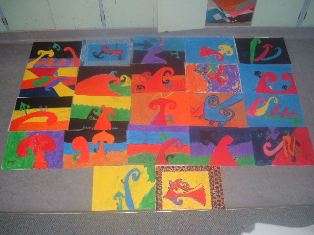Achievement Objectives
D1: Developing ideas in the Visual Arts – Students will generate and develop visual ideas in response to a variety of motivations, using imagination, observation, and intention with materials.
C1: Communicating and Interpreting in the Visual Arts – Students will describe how selected objects and images communicate different kinds of ideas
Learning Intentions/Specific Learning Objectives
- Students will recognize kowhaiwhai patterns and appreciate that they have meaning outside of their visual characteristics.
- Students will understand, name and recreate some of the shapes used In kowhaiwhai.
- Students will combine oil pastels to create value and depth.
Success Criteria
- The students will use their knowledge and skill to produce kowhaiwhai patterns of their family.
- The children will anecdote the ideas of their kowhaiwhai patterns on their draft copy.
- The children will demonstrate the use of kowhaiwhai art in their family portrait.
- The children’s kowhaiwhai patterns will keep in tradition e.g. bulb head of koiri will not touch the stem.
- The children use different colours to represent different ideas e.g. red/orange = warm.
- The student will use a contrasting colour scheme.
Assessment Methods
- Observation of class room discussion
- Work sample analysed using criteria
Lesson One
Introduction:
Show the children different kowhaiwhai patterns.
Ask the children to name examples of places they have seen them before e.g. marae, kapahaka costumes
Development:
Introduce a kowhaiwhai pattern. Practice pronunciating the vocabularly (koru, koiri, mangopare, patiki, puhoro, rauru, marama).
Point out the visual features of the pattern out e.g. koru ends in a round bulb. Draw the pattern on the whiteboard, commentate the steps like handwriting.
The children then have lots of practice drawing it in their bad pads. Repeat with the different patterns
Closure:
Review the different patterns. Discuss similarities/differences.
Lesson Two
Introduction:
Review the kowhaiwhai patterns (visual characteristics/ideas).
Brainstorm what could be in a family portrait e.g. Show the chn an example and ask the children if they can add the brainstorm.
Development:
Ask how the chn can portray a family member using pattern and colour. The children start a draft. They must include on it the ideas and the colours being used. They must be able to give reason for certain patterns and colour. Show children exemplar. Discuess using colour to achieve an effect e.g. warm/cold colours
Closure:
Show a good standard of students work to the class. Share the similarities with the exemplar. Outline the next lesson.
Lesson Three
Introduction:
Show a student’s piece of work that is ready to start a good copy – have the children analyse their own work to see if it is up to the standard of publishing.
Development:
The class work independently on their kowhaiwhai family portrait.
Roam the class and question each child on their ideas/features of their portrait.
Closure:
The children will have time at the end of the lesson to share their kowhaiwhai portraits to the class. Teacher marks to the criteria discussed in previous lessons

Above are most of the class’s kowhaiwhai unit all published.